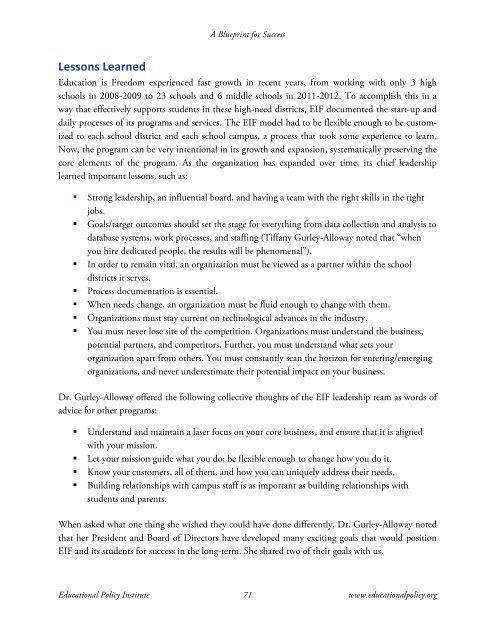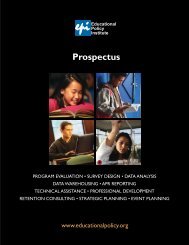A BluePrint for Success: Case Studies of Successful - Educational ...
A BluePrint for Success: Case Studies of Successful - Educational ...
A BluePrint for Success: Case Studies of Successful - Educational ...
You also want an ePaper? Increase the reach of your titles
YUMPU automatically turns print PDFs into web optimized ePapers that Google loves.
Lessons Learned<br />
A Blueprint <strong>for</strong> <strong>Success</strong><br />
Education is Freedom experienced fast growth in recent years, from working with only 3 high<br />
schools in 2008-2009 to 23 schools and 6 middle schools in 2011-2012. To accomplish this in a<br />
way that effectively supports students in these high-need districts, EIF documented the start-up and<br />
daily processes <strong>of</strong> its programs and services. The EIF model had to be flexible enough to be customized<br />
to each school district and each school campus, a process that took some experience to learn.<br />
Now, the program can be very intentional in its growth and expansion, systematically preserving the<br />
core elements <strong>of</strong> the program. As the organization has expanded over time, its chief leadership<br />
learned important lessons, such as:<br />
Strong leadership, an influential board, and having a team with the right skills in the right<br />
jobs.<br />
Goals/target outcomes should set the stage <strong>for</strong> everything from data collection and analysis to<br />
database systems, work processes, and staffing (Tiffany Gurley-Alloway noted that “when<br />
you hire dedicated people, the results will be phenomenal”).<br />
In order to remain vital, an organization must be viewed as a partner within the school<br />
districts it serves.<br />
Process documentation is essential.<br />
When needs change, an organization must be fluid enough to change with them.<br />
Organizations must stay current on technological advances in the industry.<br />
You must never lose site <strong>of</strong> the competition. Organizations must understand the business,<br />
potential partners, and competitors. Further, you must understand what sets your<br />
organization apart from others. You must constantly scan the horizon <strong>for</strong> entering/emerging<br />
organizations, and never underestimate their potential impact on your business.<br />
Dr. Gurley-Alloway <strong>of</strong>fered the following collective thoughts <strong>of</strong> the EIF leadership team as words <strong>of</strong><br />
advice <strong>for</strong> other programs:<br />
Understand and maintain a laser focus on your core business, and ensure that it is aligned<br />
with your mission.<br />
Let your mission guide what you do; be flexible enough to change how you do it.<br />
Know your customers, all <strong>of</strong> them, and how you can uniquely address their needs.<br />
Building relationships with campus staff is as important as building relationships with<br />
students and parents.<br />
When asked what one thing she wished they could have done differently, Dr. Gurley-Alloway noted<br />
that her President and Board <strong>of</strong> Directors have developed many exciting goals that would position<br />
EIF and its students <strong>for</strong> success in the long-term. She shared two <strong>of</strong> their goals with us.<br />
<strong>Educational</strong> Policy Institute 71 www.educationalpolicy.org




